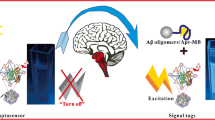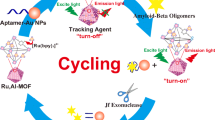Abstract
In order to effectively and conveniently detect the β-amyloid oligomer (AβO) for earlier diagnosis of Alzheimer’s disease (AD), a disposable aptamer biosensor has been developed with high performance, facile operation, and low cost. Using a nanocomposite by in situ reduction of chloroauric acid to decorate Au nanoparticles (AuNPs) on Fe-MIL-88NH2 material via Au–N bond to effectively enhance the electrochemiluminescence (ECL) of luminol, the functioned basal electrode provides adequate background for sensing response. When the aptamer is linked via Au–S bond on the surface, the sensor gets the ability of specific recognition and coalescence toward the target (AβO). After incubating the sample on the aptasensor, its ECL signal is inhibited owing to the steric hindrance of the AβO macromolecules. The relative inhibition ratio linearly depends to the logarithm of AβO concentration in the range 0.1 pM to 10 pM, with an LOD of 71 fM. The aptasensor has high selectivity to AβO among its analogs. The recoveries in human serum were 98.9–105.4%. This research provides a new approach for sensitive detection of AβO in clinic laboratories for investigation and diagnosis of AD.
Graphical abstract






Similar content being viewed by others
References
Zhu H, Zhou P, Alcauter S, Chen Y, Cao H, Tian M, Ming D, Qi H, Wang X, Zhao X, He F, Ni H, Gao W (2016) Changes of intranetwork and internetwork functional connectivity in Alzheimer’s disease and mild cognitive impairment. J Neural Eng 13(4):046008. https://doi.org/10.1088/1741-2560/13/4/046008
Vaz M, Silvestre S (2020) Alzheimer’s disease: recent treatment strategies. Eur J Pharmacol 887:173554. https://doi.org/10.1016/j.ejphar.2020.173554
Auld DS, Kornecook TJ, Bastianetto S, Quirion R (2002) Alzheimer’s disease and the basal forebrain cholinergic system: relations to β-amyloid peptides, cognition, and treatment strategies. Prog Neurobiol 68(3):209–245. https://doi.org/10.1016/S0301-0082(02)00079-5
Klaver AC, Coffey MP, Smith LM, Bennett DA, Finke JM, Dang L, Loeffler DA (2011) ELISA measurement of specific non-antigen-bound antibodies to Aβ1-42 monomer and soluble oligomers in sera from Alzheimer’s disease, mild cognitively impaired, and noncognitively impaired subjects. J Neuroinflammation 8(1):93. https://doi.org/10.1186/1742-2094-8-93
Zhao G, Wang Y, Li X, Yue Q, Dong X, Du B, Cao W, Wei Q (2019) Dual-quenching electrochemiluminescence strategy based on three-dimensional metal–organic frameworks for ultrasensitive detection of amyloid-β. Anal Chem 91(3):1989–1996. https://doi.org/10.1021/acs.analchem.8b04332
Deng C, Liu H, Si S, Zhu X, Tu Q, Jin Y, Xiang J (2020) An electrochemical aptasensor for amyloid-β oligomer based on double-stranded DNA as “conductive spring”. Microchim Acta 187(4):239. https://doi.org/10.1007/s00604-020-4217-8
Xia N, Liu L, Harrington MG, Wang J, Zhou F (2010) Regenerable and simultaneous surface plasmon resonance detection of Aβ(1−40) and Aβ(1−42) peptides in cerebrospinal fluids with signal amplification by streptavidin conjugated to an N-terminus-specific antibody. Anal Chem 82(24):10151-10157. https://doi.org/10.1021/ac102257m
Liu L, Chang Y, Yu J, Jiang M, Xia N (2017) Two-in-one polydopamine nanospheres for fluorescent determination of beta-amyloid oligomers and inhibition of beta-amyloid aggregation. Sensors Actuators B: Chem 251:359-365. https://doi.org/10.1016/j.snb.2017.05.106
Negahdary M, Heli H (2019) An ultrasensitive electrochemical aptasensor for early diagnosis of Alzheimer’s disease, using a fern leaves-like gold nanostructure. Talanta 198:510-517. https://doi.org/10.1016/j.talanta.2019.01.109
Zhu L, Zhang J, Wang F, Wang Y, Lu L, Feng C, Xu Z, Zhang W (2016) Selective amyloid β oligomer assay based on abasic site-containing molecular beacon and enzyme-free amplification. Biosensors and Bioelectronics 78:206-212. https://doi.org/10.1016/j.bios.2015.11.048
Zhou J, Meng L, Ye W, Wang Q, Geng S, Sun C (2018) A sensitive detection assay based on signal amplification technology for Alzheimer’s disease’s early biomarker in exosome. Anal Chim Acta 1022:124-130. https://doi.org/10.1016/j.aca.2018.03.016
Zhou Y, Zhang H, Liu L, Li C, Chang Z, Zhu X, Ye B, Xu M (2016) Fabrication of an antibody-aptamer sandwich assay for electrochemical evaluation of levels of β-amyloid oligomers. Sci Rep 6(1):35186. https://doi.org/10.1038/srep35186
Jiang L-F, Chen B-C, Chen B, Li X-J, Liao H-L, Huang H-M, Guo Z-J, Zhang W-Y, Wu L (2017) Detection of Aβ oligomers based on magnetic-field-assisted separation of aptamer-functionalized Fe3O4 magnetic nanoparticles and BaYF5:Yb,Er nanoparticles as upconversion fluorescence labels. Talanta 170:350–357. https://doi.org/10.1016/j.talanta.2017.04.021
Tsukakoshi K, Abe K, Sode K, Ikebukuro K (2012) Selection of DNA aptamers that recognize α-synuclein oligomers using a competitive screening method. Anal Chem 84:5542–5547. https://doi.org/10.1021/ac300330g
Toh SY, Citartan M, Gopinath SCB, Tang T-H (2015) Aptamers as a replacement for antibodies in enzyme-linked immunosorbent assay. Biosens Bioelectron 64:392–403. https://doi.org/10.1016/j.bios.2014.09.026
Li J, Guo S, Wang E (2012) Recent advances in new luminescent nanomaterials for electrochemiluminescence sensors. RSC Adv 2(9):3579-3586. https://doi.org/10.1039/C2RA01070D
Liu YL, Zhao XJ, Yang XX, Li YF (2013) A nanosized metal–organic framework of Fe-MIL-88NH2 as a novel peroxidase mimic used for colorimetric detection of glucose. Analyst 138(16):4526–4531. https://doi.org/10.1039/C3AN00560G
Sun Z, Liu Y, Li Y (2015) Selective recognition of 6-mercaptopurine based on luminescent metal–organic frameworks Fe-MIL-88NH2. Spectrochim Acta A Mol Biomol Spectrosc 139:296–301. https://doi.org/10.1016/j.saa.2014.12.009
Hu M, Wang Y, Yang J, Sun Y, Xing G, Deng R, Hu X, Zhang G (2019) Competitive electrochemical immunosensor for maduramicin detection by multiple signal amplification strategy via hemin@Fe-MIL-88NH2/AuPt. Biosens Bioelectron 142:111554. https://doi.org/10.1016/j.bios.2019.111554
Rowsell JLC, Yaghi OM (2004) Metal–organic frameworks: a new class of porous materials. Microporous Mesoporous Mater 73(1):3–14. https://doi.org/10.1016/j.micromeso.2004.03.034
Ke F, Qiu L-G, Zhu J (2014) Fe3O4@MOF core–shell magnetic microspheres as excellent catalysts for the Claisen–Schmidt condensation reaction. Nanoscale 6(3):1596–1601. https://doi.org/10.1039/C3NR05051C
Zhao S, Zhang Y, Ding S, Fan J, Luo Z, Liu K, Shi Q, Liu W, Zang G (2019) A highly sensitive label-free electrochemical immunosensor based on AuNPs-PtNPs-MOFs for nuclear matrix protein 22 analysis in urine sample. J Electroanal Chem 834:33–42. https://doi.org/10.1016/j.jelechem.2018.12.044
Liu L, Zhou Y, Liu S, Xu M (2018) The applications of metal−organic frameworks in electrochemical sensors. ChemElectroChem 5(1):6–19. https://doi.org/10.1002/celc.201700931
Li Y, Yu C, Yang B, Liu Z, Xia P, Wang Q (2018) Target-catalyzed hairpin assembly and metal-organic frameworks mediated nonenzymatic co-reaction for multiple signal amplification detection of miR-122 in human serum. Biosens Bioelectron 102:307–315. https://doi.org/10.1016/j.bios.2017.11.047
Xie S, Ye J, Yuan Y, Chai Y, Yuan R (2015) A multifunctional hemin@metal–organic framework and its application to construct an electrochemical aptasensor for thrombin detection. Nanoscale 7(43):18232-18238. https://doi.org/10.1039/C5NR04532K
Cheng S, Liu H, Zhang H, Chu G, Guo Y, Sun X (2020) Ultrasensitive electrochemiluminescence aptasensor for kanamycin detection based on silver nanoparticle-catalyzed chemiluminescent reaction between luminol and hydrogen peroxide. Sensors Actuators B Chem 304:127367. https://doi.org/10.1016/j.snb.2019.127367
Chen F, Wang D, Chen J, Ling J, Yue H, Gou L, Tang H (2020) PtNi nanocubes-catalyzed tyramine signal amplification electrochemiluminescence sensor for nonenzymatic and ultrasensitive detection of hepatocellular carcinoma cells. Sensors Actuators B Chem 305:127472. https://doi.org/10.1016/j.snb.2019.127472
Chen Y, Zhou S, Li L, Zhu J-j (2017) Nanomaterials-based sensitive electrochemiluminescence biosensing. Nano Today 12:98–115. https://doi.org/10.1016/j.nantod.2016.12.013
Zhang Y, Wei Q (2016) The role of nanomaterials in electroanalytical biosensors: a mini review. J Electroanal Chem 781:401–409. https://doi.org/10.1016/j.jelechem.2016.09.011
Liu YL, Fu WL, Li CM, Huang CZ, Li YF (2015) Gold nanoparticles immobilized on metal–organic frameworks with enhanced catalytic performance for DNA detection. Anal Chim Acta 861:55–61. https://doi.org/10.1016/j.aca.2014.12.032
Xie S, Ye J, Yuan Y, Yaqin C, Yuan R (2015) A multifunctional hemin@metal-organic framework and its application to construct an electrochemical aptasensor for thrombin detection. Nanoscale 7:18232–18238. https://doi.org/10.1039/c5nr04532k
Wang X, Zhai S, Liu C, Wang X, Yang Y, Tu Y (2019) A convenient electrochemiluminescent immunosensor for detecting methamphetamine antibody. Anal Sci 35(8):875-882. https://doi.org/10.2116/analsci.19P051
Tsukakoshi K, Abe K, Sode K, Ikebukuro K (2012) Selection of DNA aptamers that recognize α-synuclein oligomers using a competitive screening method. Anal Chem 84(13):5542-5547. https://doi.org/10.1021/ac300330g
Kasai T, Tokuda T, Taylor M, Kondo M, Mann DMA, Foulds PG, Nakagawa M, Allsop D (2013) Correlation of Aβ oligomer levels in matched cerebrospinal fluid and serum samples. Neurosci Lett 551:17-22. https://doi.org/10.1016/j.neulet.2013.06.029
Funding
This work is financially supported by the National Natural Science Foundation of China (21675115, 21375091).
Author information
Authors and Affiliations
Corresponding authors
Ethics declarations
All procedures performed in studies involving human participants were in accordance with the ethical standards of the institutional research committee and with the 1964 Helsinki declaration and its later amendments or comparable ethical standards. Protocol number: 2019(264), the First Affiliated Hospital of Soochow University.
Conflict of interest
The authors declare that they have no competing interests.
Additional information
Publisher’s note
Springer Nature remains neutral with regard to jurisdictional claims in published maps and institutional affiliations.
Supplementary information
ESM 1
(DOC 976 kb)
Rights and permissions
About this article
Cite this article
Yin, L., Wang, Y., Tan, R. et al. Determination of β-amyloid oligomer using electrochemiluminescent aptasensor with signal enhancement by AuNP/MOF nanocomposite. Microchim Acta 188, 53 (2021). https://doi.org/10.1007/s00604-021-04710-7
Received:
Accepted:
Published:
DOI: https://doi.org/10.1007/s00604-021-04710-7




